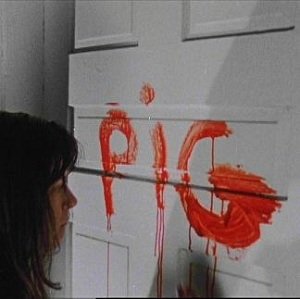THE MANSON FAMILY: Filmmaking From Within The Abyss
If you followed underground filmmaking late 1980's/early 1990's - particularly that of the horror variety - you probably heard about "Charlie's Family," the film that would eventually become The Manson Family. It was the work of young actor/writer/director/editor/fx man Jim Van Bebber, who had recently earned notoriety in cult circles for his grindhouse gang epic Deadbeat At Dawn.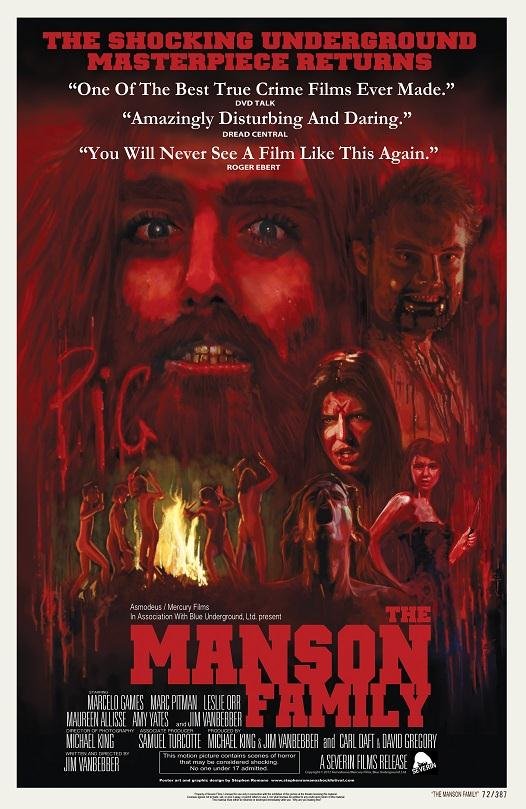 Van Bebber set out to make his own personalized, no-bullshit, no mercy take on the Manson mythos but the film got stuck in limbo due to lack of funding and business deals constantly falling through. Scenesters moved from excitement to impatience to indifference as year after year passed without a formal release of the film. Still, he kept shooting it in a piecemeal fashion between 1988 and 1997, finally wrapping post production - on his own terms, natch - in 2003.The results were worth the wait, as this is a Manson movie like no other. First off, Manson (Marcelo Games) isn't the main figure of the tale - he's more of a catalyst. The real prime movers are his most fervent followers - Tex (Marc Pitman), Sadie (Maureen Allisse), Patty (Leslie Orr), Bobby (Van Bebber) and Leslie (Amy Yates). Each of the supposed disciples is really just enjoying playing out power games and living at the edge of their sanity, using Manson's ‘teachings’ as an excuse to plunge into an abyss of drugs, sex, and ultimately, some of the most vicious murders in recorded history.The tale of how
Van Bebber set out to make his own personalized, no-bullshit, no mercy take on the Manson mythos but the film got stuck in limbo due to lack of funding and business deals constantly falling through. Scenesters moved from excitement to impatience to indifference as year after year passed without a formal release of the film. Still, he kept shooting it in a piecemeal fashion between 1988 and 1997, finally wrapping post production - on his own terms, natch - in 2003.The results were worth the wait, as this is a Manson movie like no other. First off, Manson (Marcelo Games) isn't the main figure of the tale - he's more of a catalyst. The real prime movers are his most fervent followers - Tex (Marc Pitman), Sadie (Maureen Allisse), Patty (Leslie Orr), Bobby (Van Bebber) and Leslie (Amy Yates). Each of the supposed disciples is really just enjoying playing out power games and living at the edge of their sanity, using Manson's ‘teachings’ as an excuse to plunge into an abyss of drugs, sex, and ultimately, some of the most vicious murders in recorded history.The tale of how 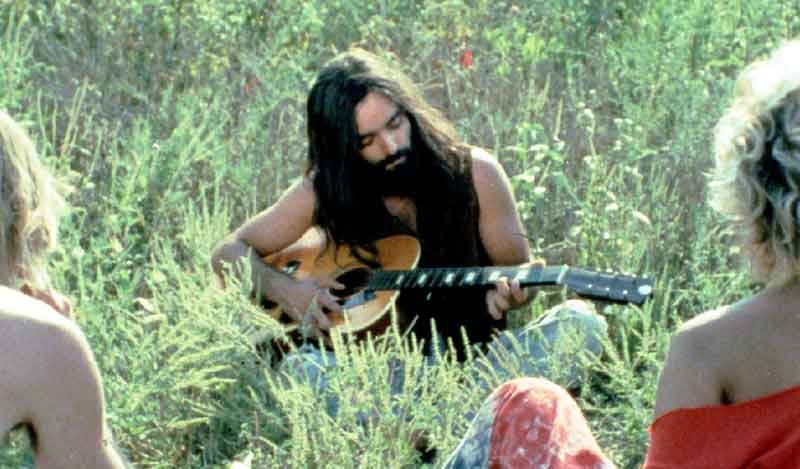 the followers' madness boiled over, culminating in the Tate and LaBianca murders, forms the narrative backbone of The Manson Family. However, Van Bebber utilizes a cut-up narrative style, weaving in a parallel storyline of how a group of Manson-influenced junkie kids plot to murder a newsman who angers them by doing a modern Manson expose. The two story lines are given a link - and a third layer of commentary on the events - via modern-day recollections from the Manson disciples from their prison cells, all contradicting each other as they reshape events to fit their vantage point.The end result is as much as sensory overload experience as it is a narrative film. Van Bebber effectively utilizes the hallucinatory visual style (perfectly captured by producer/d.p. Mike King) and elliptical editing style of movies from the era he portrays - namely Easy Rider, Performance and The Last Movie -
the followers' madness boiled over, culminating in the Tate and LaBianca murders, forms the narrative backbone of The Manson Family. However, Van Bebber utilizes a cut-up narrative style, weaving in a parallel storyline of how a group of Manson-influenced junkie kids plot to murder a newsman who angers them by doing a modern Manson expose. The two story lines are given a link - and a third layer of commentary on the events - via modern-day recollections from the Manson disciples from their prison cells, all contradicting each other as they reshape events to fit their vantage point.The end result is as much as sensory overload experience as it is a narrative film. Van Bebber effectively utilizes the hallucinatory visual style (perfectly captured by producer/d.p. Mike King) and elliptical editing style of movies from the era he portrays - namely Easy Rider, Performance and The Last Movie -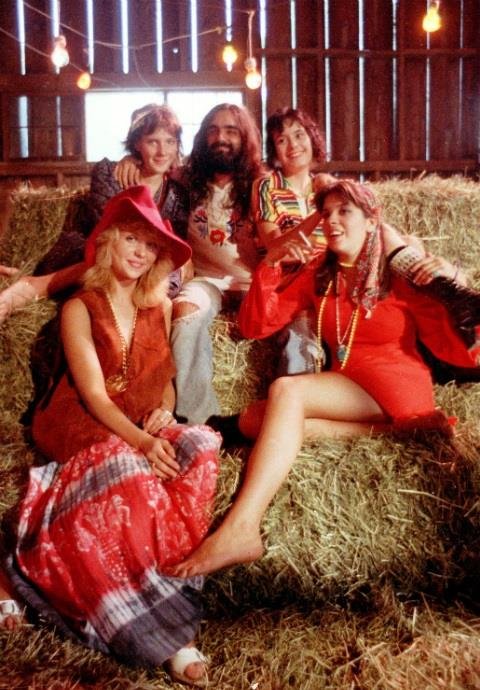 to echo the contrasting perspectives of characters and their jangled nerves. He also uses a complex sound mix that adds every possible background element from Manson songs to animal noises to Jim Jones speeches to get under the viewer's skin.And Van Bebber doesn't shy away from the extreme content of his chosen story - the ritualistic drug orgies and the horrifying murders are all depicted in a vivid style. The climactic depictions of the Tate and LaBianca massacres are amongst the most gut-wrenching depictions ever filmed of any murder and are likely to make even the hardiest horror aficionado squirm. That said, despite the very NC-17 levels of sex and violence on display here, it never feels gratuitous - it just feels honest. Van Bebber teeters on the edge (a necessity in telling this story, at least to these eyes) but never falls off.Better yet, unlike other filmmakers who explore this material, Van Bebber knows when to quit. It's telling of his skill and his respect for the material that he uses fast cuts to make you think you see more than you actually do during the brutal moments and manages to suggest the very worst incidents without showing them in det
to echo the contrasting perspectives of characters and their jangled nerves. He also uses a complex sound mix that adds every possible background element from Manson songs to animal noises to Jim Jones speeches to get under the viewer's skin.And Van Bebber doesn't shy away from the extreme content of his chosen story - the ritualistic drug orgies and the horrifying murders are all depicted in a vivid style. The climactic depictions of the Tate and LaBianca massacres are amongst the most gut-wrenching depictions ever filmed of any murder and are likely to make even the hardiest horror aficionado squirm. That said, despite the very NC-17 levels of sex and violence on display here, it never feels gratuitous - it just feels honest. Van Bebber teeters on the edge (a necessity in telling this story, at least to these eyes) but never falls off.Better yet, unlike other filmmakers who explore this material, Van Bebber knows when to quit. It's telling of his skill and his respect for the material that he uses fast cuts to make you think you see more than you actually do during the brutal moments and manages to suggest the very worst incidents without showing them in det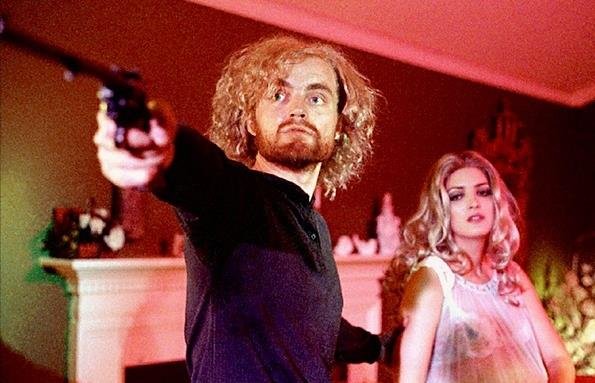 ail (example: a horrifying gang rape is suggested entirely through a barrage of extreme close-ups interspersed with an occasional shot from the victim's p.o.v.). He also finds moments of odd poignancy between the horrors - the sequence of the fatally wounded Abigail Folger trying to stagger away from the murder site is as heartbreaking as it is stomach-churning.It's also worth noting that the actors match Van Bebber in the commitment department. Games does an impressive Manson, convincing in how he handles both the playful and vicious sides of the character, and Allisse and Orr are both frighteningly intense as two of the key female famil
ail (example: a horrifying gang rape is suggested entirely through a barrage of extreme close-ups interspersed with an occasional shot from the victim's p.o.v.). He also finds moments of odd poignancy between the horrors - the sequence of the fatally wounded Abigail Folger trying to stagger away from the murder site is as heartbreaking as it is stomach-churning.It's also worth noting that the actors match Van Bebber in the commitment department. Games does an impressive Manson, convincing in how he handles both the playful and vicious sides of the character, and Allisse and Orr are both frighteningly intense as two of the key female famil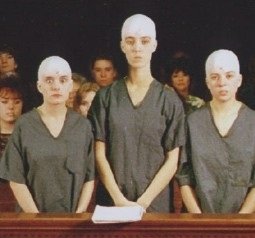 y members. Their theatrical take on their characters sometimes threatens to go too far but their conviction carries them through - a monologue that Orr does about the "mission" of the Manson family to Tex is unforgettable. Van Bebber himself impresses as Bobby, particularly in a grim and difficult scene where he has to murder Gary Hinman. That said, the best work might come from Pitman as Tex, who functions as the audience's entry into Manson's sordid world. He tackles Tex's journey from opportunistic skeptic to the most brutal of Manson's killers with an uninhibited yet thoroughly believable intensity.One wo
y members. Their theatrical take on their characters sometimes threatens to go too far but their conviction carries them through - a monologue that Orr does about the "mission" of the Manson family to Tex is unforgettable. Van Bebber himself impresses as Bobby, particularly in a grim and difficult scene where he has to murder Gary Hinman. That said, the best work might come from Pitman as Tex, who functions as the audience's entry into Manson's sordid world. He tackles Tex's journey from opportunistic skeptic to the most brutal of Manson's killers with an uninhibited yet thoroughly believable intensity.One wo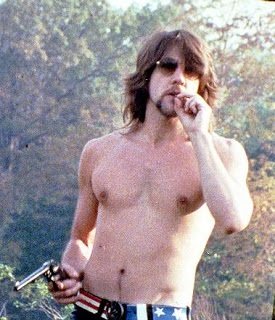 rd of warning, though - keep in mind that The Manson Family is not a perfect film. Despite an impressive overall sense of detail, some rough edges show through: for instance, the phony-looking mustache Van Bebber wears in the latter-day footage as Bobby is distracting. The film's biggest problem is that the modern-day plotline doesn't fully work: it's great in theory but, when contrasted with the lived-in performances and feverish intensity of the Manson-era stuff, it feels too self-conscious and pales in comparison. As a result, the modern finale feels anticlimatic in comparison to the Manson family murder scenes it follows.However, The Manson Family remains a stunning, important piece of work despite these minor missteps. When one considers the piece-meal nature of its creation, it's amazing just how focused and incisive it really is. This is no mere grindhouse work - it comments with startling accuracy about how people can shift blame to justify their worst actions and how the media can perpetuate ugly myths that not only obscure the truth but send society in the wrong direction. Simply put, anyone with an interest in modern underground filmmaking or the story of Charles Manson needs to see The Manson Family.
rd of warning, though - keep in mind that The Manson Family is not a perfect film. Despite an impressive overall sense of detail, some rough edges show through: for instance, the phony-looking mustache Van Bebber wears in the latter-day footage as Bobby is distracting. The film's biggest problem is that the modern-day plotline doesn't fully work: it's great in theory but, when contrasted with the lived-in performances and feverish intensity of the Manson-era stuff, it feels too self-conscious and pales in comparison. As a result, the modern finale feels anticlimatic in comparison to the Manson family murder scenes it follows.However, The Manson Family remains a stunning, important piece of work despite these minor missteps. When one considers the piece-meal nature of its creation, it's amazing just how focused and incisive it really is. This is no mere grindhouse work - it comments with startling accuracy about how people can shift blame to justify their worst actions and how the media can perpetuate ugly myths that not only obscure the truth but send society in the wrong direction. Simply put, anyone with an interest in modern underground filmmaking or the story of Charles Manson needs to see The Manson Family.
TMF Trailer 2013 RedBand from Severin Films on Vimeo.


